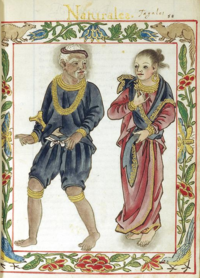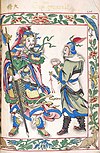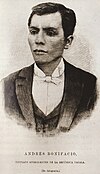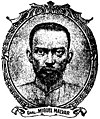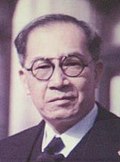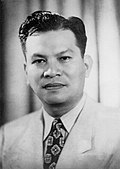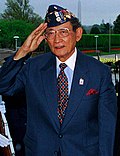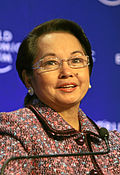
Miguel López de Legazpi, also known as El Adelantado and El Viejo, was a Spanish conquistador who financed and led an expedition to conquer the Philippine islands in the mid-16th century. He was joined by Guido de Lavezares, relative Martin de Goiti, friar Andrés de Urdaneta, and his grandsons Juan and Felipe de Salcedo, in the expedition. Legazpi established the first Spanish settlement in the East Indies after his expedition crossed the Pacific Ocean, arriving in Cebu in 1565. He became the first Governor-General of the Spanish East Indies, which was administered from New Spain for the Spanish crown. It also encompassed other Pacific islands, namely Guam, the Mariana Islands, Palau, and the Carolinas. After obtaining peace with various indigenous tribes and kingdoms, he made Cebu City the capital of the Spanish East Indies in 1565 and later transferred to Manila in 1571. The capital city of the province of Albay bears his name.
The military history of the Philippines is characterized by wars between Philippine kingdoms and its neighbors in the precolonial era and then a period of struggle against colonial powers such as Spain and the United States, occupation by the Empire of Japan during World War II and participation in Asian conflicts post-World War II such as the Korean War and the Vietnam War. The Philippines has also battled a communist insurgency and a secessionist movement by Muslims in the southern portion of the country.

The Battle of Mactan was fought on a beach in Mactan Island between Spanish forces led by the Portuguese explorer Ferdinand Magellan along with local allies, and Lapulapu, the chieftain of the island, on the early morning hours of April 27, 1521. Magellan, a Portuguese-born commander serving the Spanish Empire who led an expedition that ultimately circumnavigated the world for the first time, commanded a small Spanish contingent in an effort to subdue Mactan led by Lapulapu under the Spanish crown. The sheer number of Lapulapu's forces, compounded with issues on the location and armor, ultimately resulted in a disastrous defeat to the Europeans and the death of Magellan. Surviving members of Magellan's crew continued the expedition under the command of Juan Sebastian de Elcano, who completed the journey in September 1522.
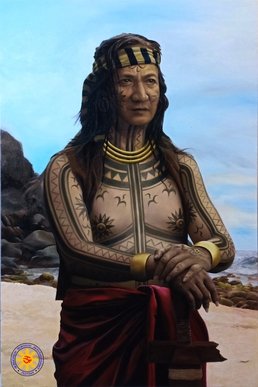
Lapulapu or Lapu-Lapu, whose name was first recorded as Çilapulapu, was a datu (chief) of Mactan, an island now part of the Philippines. Lapulapu is known for the 1521 Battle of Mactan, where he and his men defeated Spanish forces led by Portuguese explorer Ferdinand Magellan and his native allies Rajah Humabon and Datu Zula. Magellan's death in battle ended his voyage of circumnavigation and delayed the Spanish occupation of the islands by over forty years until the expedition of Miguel López de Legazpi in 1564.

Juan de Salcedo was a Spanish conquistador. He was the grandson of Spanish general Miguel López de Legazpi. Salcedo was one of the soldiers who accompanied the Spanish conquest to the Philippines in 1565. He joined the Spanish military in 1564 at age 15, on their voyage of exploration to the East Indies and the Pacific, in search of rich resources such as gold and spice, and to find a passage to the islands were the previous Spanish expeditions led by Ferdinand Magellan had landed in 1521, and Ruy López de Villalobos in 1543.

Sulayman, sometimes referred to as Sulayman III, was a Crown Prince of the Kingdom of Luzon in the 16th century and was a nephew of King Ache of Luzon. He was the commander of Luzonian forces in the battle of Manila of 1570 against Spanish forces.
Lakandula was the title of the last lakan or paramount ruler of pre-colonial Tondo when the Spaniards first conquered the lands of the Pasig River delta in the Philippines in the 1570s.
Martín de Goiti was a Spanish conquistador and one of the soldiers who accompanied the Spanish voyage of exploration to the East Indies and the Pacific in 1565, in search of rich resources such as gold, spice and settlements. They were seeking to find a route to the islands were the previous Spanish expeditions led by Ferdinand Magellan had landed in 1521, and Ruy López de Villalobos in 1543.
Datu Sikatuna was a Datu or chieftain of the Bool Kingdom in the island of Bohol in the Philippines. He made a blood compact (sanduguan) and alliance with the Spanish explorer Miguel López de Legazpi on March 25, 1565 at Hinawanan Bay, barangay Hinawanan, Loay. Their blood compact is the first Treaty of Friendship between Spain and the Philippines. The previous site of the pact was thought to have been at barangay Bool, Tagbilaran City but later a panel of historians concluded that the event actually happened at barangay Hinawanan, Loay, Bohol as ratified through Resolution No. 4, issued by the National Historical Institute in 2005.
Datu Daya was a legendary lord of Kandaya, the place that is now known as Daanbantayan, Cebu, in the Philippines.
Rajah Humabon, later baptized as Don Carlos Valderrama, was a King of Cebu in the 16th century.

In early Philippine history, the Tagalog settlement at Tondo sometimes referred to as the Kingdom of Tondo, was a major trade hub located on the northern part of the Pasig River delta, on Luzon island. Together with Maynila, the polity (bayan) that was also situated on the southern part of the Pasig River delta, had established a shared monopoly on the trade of Chinese goods throughout the rest of the Philippine archipelago, making it an established force in trade throughout Southeast Asia and East Asia.

In early Philippine history, the rank of lakan denoted a "paramount ruler" of one of the large coastal barangays on the central and southern regions of the island of Luzon.

Akí, also known as Rája Matandâ, was King of Luzon who ruled from the kingdom's capital Manila, now the capital of the Republic of the Philippines.

The known recorded history of the Philippines between 900 and 1565 begins with the creation of the Laguna Copperplate Inscription in 900 and ends with the beginning of Spanish colonization in 1565. The inscription records its date of creation in the year 822 of the Hindu Saka calendar, corresponding to 900 AD in the Gregorian calendar. Therefore, the recovery of this document marks the end of the prehistory of the Philippines at 900 AD. During this historical time period, the Philippine archipelago was home to numerous kingdoms and sultanates and was a part of the theorized Indosphere and Sinosphere.

The 1570 Battle of Manila was fought in Manila between Luzonians, led by Prince Sulayman, and Spaniards, led by field marshal Martin de Goiti, on 24 May 1570. Goiti's forces eventually besieged the fort of Manila, destroyed Manila, and won the battle, with the site of the fort falling to the Kingdom of the Spains and the Indies. The Spaniards then founded a Spanish city of Manila making it the capital of the Spanish East Indies.
Datu Magat Salamat was a Filipino historical figure best known for co-organizing the Tondo Conspiracy of 1587. He was one of at least four sons of Lakandula, and thus held the title of Datu under his cousin and co-conspirator Agustin de Legazpi, who had been proclaimed paramount ruler of the indianized kingdom of Tondo after the death of Lakandula, although the position soon became little more than a courtesy title.
Agustin de Legazpi is a prominent historical figure in the Philippines best known as the leader of the Tondo Conspiracy of 1587–1588, the last native ruler of Tondo, and the last individual to hold the title of paramount ruler in any of the Indianized indigenous Tagalog polities of the Pasig River delta, although it had been reduced to little more than a courtesy title by the time of Agustin de Legazpi's execution. He was a great grandson of the Bruneian Sultan and distant descendant of Caliph Hasan ibn Ali and was a convert from Islam to Christianity, his Bruneian name was Rajah Muhammad Zahir al-Din.
Kandarapa was a native Filipina princess of the Kingdom of Tondo in the island of Luzon during the 16th century Spanish conquest of the Philippines, and the wife of the Spanish conquistador Juan de Salcedo. She was described as a beautiful young woman who came from a tribal royal family. Kandarapa was the niece of Rajah Lakandula, the king of Tondo, and the daughter of Bunao Lakandula's sister, Princess Salanta, who became a widow at a young age. She was named after the native Filipino Kandarapa bird, a lark that frequently stayed amongst the rice padies, whose songs she imitated with her beautiful voice. Her uncle, the king, resisted conversion to Islam and remained to his native Filipino (Hindu-Malay) religion of his forebears and although Tondo was an older kingdom, it ceded power to Manila which was established as a satellite state subservient to the Sultanate of Brunei after a Bruneian settlement of Luzon. Islam was brought to the islands by preachers that had travelled from the islands of Borneo and Indonesia. During this period, Islam had slowly began converting the native tribes of Luzon. Lakandula, desirous of forging an alliance with the much more powerful Rajah of Macabebe, Tariq Sulayman, betrothed her niece to the Rajah of Macabebe, an arrangement Princess Kandarapa disapproved because he already had multiple wives from previous marriages as a result of his Islamic tradition. Had the Spaniards arrived a century later, the Philippines would have been an Islamic country.

